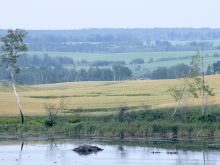BENGOUGH, Sask. – Two years ago Keith Whyte fell off his tractor and into a whole new world.
In this world he spends two weeks of every month undergoing chemotherapy, driving from his farm home in the Big Muddy near Bengough, Sask., to Regina and Weyburn for treatment. He learned to sing and raises money for cancer research, performing classic country standards. And, he became a media star, drawing attention to the need to fund the drug Avastin.
He’s recognized at gas stations. People he’s never met call him out of the blue for advice.
Read Also

Rural Manitoba resources slim on natural disaster planning
A study from Brandon University’s Rural Development Institute has found that many rural and small municipalities don’t have the staff or resources to make formal climate plans against natural disaster.
It’s a far cry from the old world in which he farmed and played hockey across Canada until he was nearly 60, never imagining that cancer would change his life so completely.
After he fell in June 2006, endured an eight-hour surgery, nearly died and was diagnosed with terminal Stage 4 colon cancer, he was expected to live only four to six months.
He’s 64 now. He lists off his cancers matter-of-factly.
“Two tumours in my left lung, one on the right lung, one in the sigmoid, two in my liver,” he says, pointing to each location. “They removed one big one from my colon and now I’ve got a new one on the scar and into my stomach.”
It’s no use being depressed about it, Whyte said. Attitude is probably why he’s still alive and fighting.
Whyte grew up in the Big Muddy and turned out to be a good hockey player. He was playing defence for Senior A teams by the time he was 16 and still loves the game.
He chuckles when asked about the cap and vest he is wearing. Both are embroidered with the words LeBlanc Farms.
The boys from the nearby Willow Bunch hockey team, a predominantly French community, had tagged him with a nickname – le blanc – to reflect his name in their language.
“They hate you on the ice, you know,” Whyte said.
But he turned the tables and adopted it for the farm he first seeded in 1962.
The farm is a little smaller than it used to be. Whyte had to sell some land and his cattle to cover the $2,500-per-treatment cost of Avastin. Patients require two treatments each month.
He farms seven quarters now and planted his crop this spring between chemotherapy treatments. Help is not close at hand. Many of his neighbours have cancer too.
Whyte’s farm lies near the coal-fired power station at Coronach and underneath the lines that carry the electricity away from the plant.
He believes living under the line and using farm chemicals may have caused his disease.
He quit spraying his crops eight to 10 years ago, but admits that, like many other farmers, he wasn’t always careful when handling chemicals.
Several neighbours have prostate and spine cancers. Others have already died from the disease.
Whyte said having easier access to Avastin would have helped him. Avastin works with chemotherapy to help prolong cancer patients’ lives. It can be used for colorectal, lung and breast cancer.
When first diagnosed, he obtained a $5,000 loan to get started on the treatment.
Six months and $30,000 later, he was broke. He couldn’t continue the treatment.
In the meantime, the then-opposition Saskatchewan Party had been lobbying the NDP government to cover at least part of the cost of Avastin under the provincial drug plan.
Whyte became involved in that effort.
“(The government) told me we were fortunate to even have the drug in Saskatchewan,” he said of the response. “They didn’t think little old farmer me would get enough media attention.”
In January 2008, the new government announced full coverage of Avastin and two other drugs, along with research money and six extra chairs for chemo treatment. It’s all worth about $6 million annually.
“It wasn’t a two-bit issue,” Whyte said.
Health minister Don McMorris said he admires Whyte for putting his face on the issue.
“In his situation a lot of people would suffer silently, not fight for what you think needs to be done,” he said.
“I don’t know if any of us can imagine going through what he goes through.”
While the fight was successful, it was too late for Whyte. He’d been off Avastin too long to start taking it again.
He has had more than 40 chemo treatments now, as well as some radiation therapy. Jane, his 16-year-old Beagle, who knew when he was sick, almost always accompanies him.
It’s still a struggle to pay for the cost of travelling for his treatment. He needs his farm income to repay people who provide loans.
But he focuses on raising money for the Saskatchewan Cancer Society instead, hoping others will be more fortunate.
He has adopted another nickname, combining his name and his treatment to become Old Man Keimo.
He has performed at several events, singing country classic hits with help from his karaoke machine. The music comes with a twist, though, a bit of a lecture on living life the best way you can and why people should reach out to those with cancer.
“We’re not stupid. We’re not ingrates,” Whyte said. “I’ve been called ‘you people.’
“Don’t shun the people with cancer. We still want to be part of the world.”
Whyte continues to speak out and lobby for better services for cancer patients, including patient advocates who can help the newly diagnosed navigate their way through the system. He is also a strong believer in prevention.
His efforts haven’t gone unnoticed and this fall, perhaps around the time he is harvesting, he will be nominated for a national advocacy award.
Through it all he fights his own fight.
“There is a lot of pain,” he admits. “You learn to be humble, to smile, to handle pain and battle, battle, battle.”















